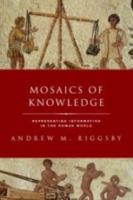
OUP (2019) h/b 248pp £47.99 (ISBN 9780190632502)
This detailed academic study is accompanied by a number of tables, figures and colour plates, as well as footnotes, an extensive bibliography and a comprehensive index. Potential readers should note that it is not about mosaics, but is rather an investigation of ‘information technologies’ in the classical Roman world, specifically those produced in Latin from earliest times to about AD 300, thus excluding anything in Greek. The mosaics in the title echo the tessellation which R. posits existed in the ancient Roman world, describing it as ‘a balkanized informational world’ i.e. there was little sharing of practices in organising information or establishing common standards either between different geographical locations or different classes and occupations.
R. establishes very precise parameters for his investigations and rigorously prescribed definitions of the objects and concepts which he is examining. His first chapter is devoted to specialised types of lists, such as those in alphabetical or chronological order, and he concludes that such lists were rarely, if at all, used to provide data for contemplation. R. moves on to tables, defining them very strictly and finding that most of what have been considered examples of table are in fact merely lists. Army rostra and accounts, for example, are considered on closer examination to be mostly narrative, not tabular. Chapter 3 considers weights and measures. These were generally standardised locally, but even then apparently accurate measuring equipment varies to some extent in size or capacity. The Romans legislated against selling goods in short quantity, but do not seem to have been able to produce accurate measuring devices. For example, the denarius, widely used as a measuring weight for small quantities by pharmacists, could itself vary considerably in weight. R. also discusses the seeming contradiction that buildings were constructed with millimetre accuracy and reflects on the widespread use of ratios in measurement.
R. moves on to a rather different topic in the following chapter, exploring Roman wall paintings and their apparent lack of accurate perspective. He looks at standard topological devices such as tiering and shading to indicate three-dimensions. There follows a chapter on two-dimensional representations, specifically maps, graphics, illustrations and building plans, concluding that such items were mostly not strictly accurate and were occasional and ad hoc.
Throughout this tome R. is meticulous in discussing the views of other scholars and in providing evidence for his own theories. It is a work of specialised scholarship, rather than aimed at the general reader.
Marion Gibbs
